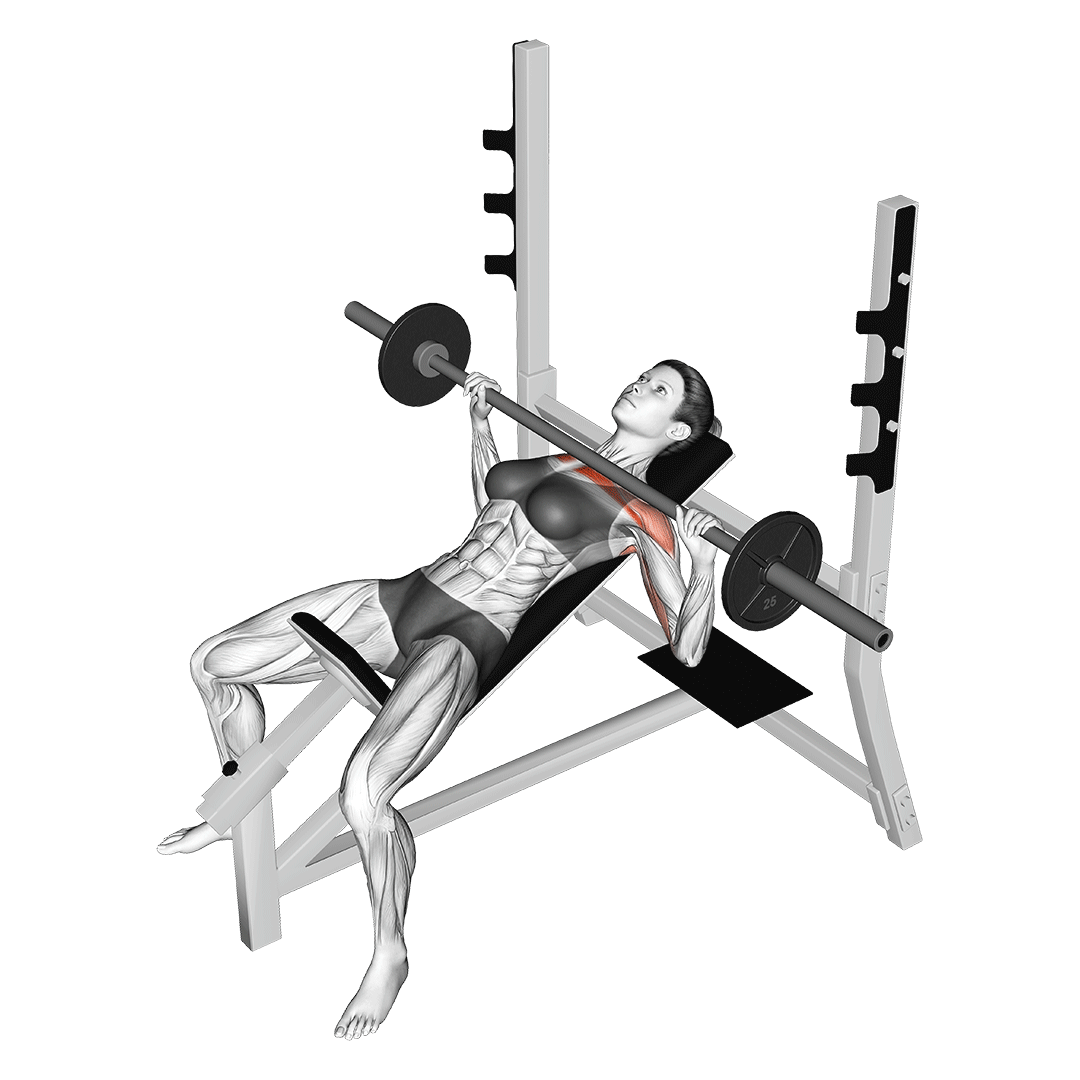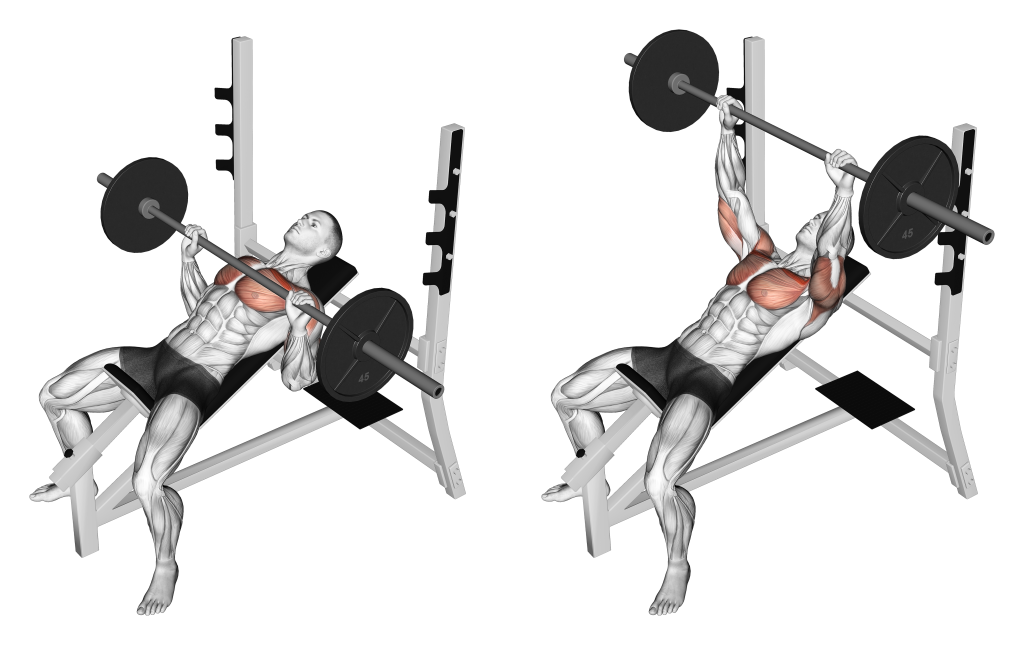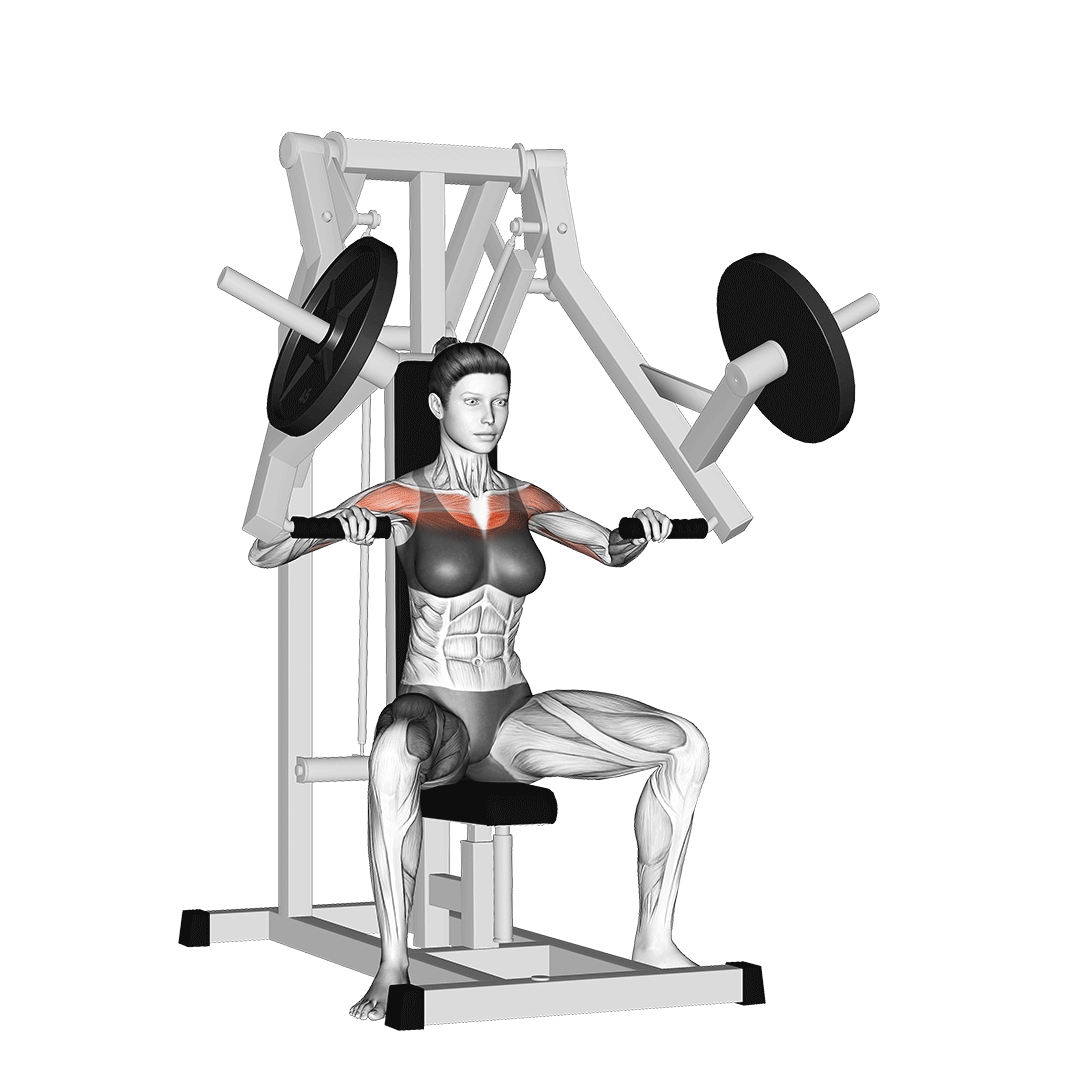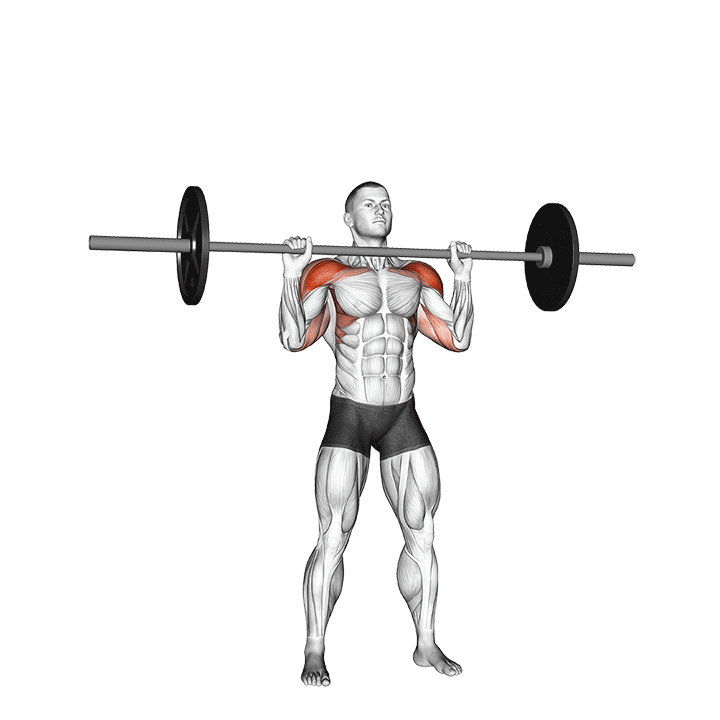Incline Barbell Bench Press: Benefits, Muscles Worked, and More
The incline barbell bench press is a closed chain compound pushing exercise meant to target the chest, shoulders and triceps to high intensity.

Most often, the incline barbell bench press is performed with an incline bench set between a 30 and 45 degree incline. This allows the lifter to maximize emphasis on the superior section (clavicular head) of the pectoralis major, and will subsequently also target the anterior head of the deltoids as well.
Incline bench presses are often used as either a supplement to the flat bench press or as an alternative in lifters who find the development of their upper chest to be insufficient.
Of course, the opposite is also possible, and over-reliance on the incline bench press can lead to poor development of the lower section of the chest. Program accordingly.
Is the Incline Bench Press Right for You?
Because of the slightly greater injury risk on account of performing the exercise at an incline, the incline barbell bench press is more suitable for intermediates or those who have already mastered the flat bench press.
Individuals with a history of rotator cuff or shoulder injuries should avoid the incline bench press, as it may lead to further damage.
How to Do an Incline Bench Press
To perform a repetition of the incline bench press, the lifter will begin by first setting an incline bench between 30 and 45 degrees beneath a bar - lying atop the bench with their scapula retracted and their lower back arched.
The hands should be approximately shoulder-width along the barbell, chin tucked into the neck. The core hips should be pressed into the bench, with the feet either driving into the floor or raised.
Now in the correct stance, the lifter unracks the bar and slowly lowers it to their sternum by bending at the elbows.
Unlike the flat bench press which occasionally features a touchpoint somewhere below the mid-chest, the incline bench press is meant to touch the bar far higher along the torso.
Once the bar makes contact with the chest, the lifter squeezes their pectoral muscles and drives through their palms. This should extend their arms back upwards, returning the bar to its original position at the start of the repetition.
At this point, one rep has been completed.
What are the Benefits of Doing The Incline Bench Press?
The incline bench press is commonly practiced for its widely-applicable benefits - of which we’ve listed below.
Excellent for Building Upper Chest Mass and Overhead Pressing Strength
The main benefit to doing the incline bench press is its capacity to emphasize the upper chest and shoulders. This not only improves definition and general mass in the area, but also enhances pressing strength in both horizontal and vertical directions.

When performed in combination with exercises that target the medial deltoids and the lower section of the chest, a well-rounded and overall muscular appearance to the upper body can be achieved.
Even discounting the muscle mass developed by incline bench pressing, the anterior deltoids and upper chest both play an important role in exercises like the overhead press and handstand push-up - both being vertical pressing exercises that benefit from the incline bench press.
Less Weight Needed to Reach Training Intensity
Because the incline bench press features a significantly more disadvantageous position, lifters will not be able to load as much weight as they would otherwise be able with a flat bench press.
While this does mean that the incline bench press is less useful for strength training or conditioning, it also equates to less strain on the joints and less equipment needed overall.
Pairs Well With the Flat and Decline Bench Press
Because the incline bench press tends to emphasize the upper section of the chest, it goes without saying that performing it alongside the flat or decline variations allows for full development of the pectoral muscles.
This doesn’t mean that the incline bench press fails to contract the lower section of the chest - the entirety of the pectoral muscle group activates as a single unit. However, for a more evenly distributed training stimulus, pairing the incline bench with its counterparts is ideal.
Teaches Bar Control and Touchpoint Consistency
Controlling the bar during an incline bench press is considerably more difficult than with a flat bench.
With regular performance, lifters will find that their control over the bar during any bench press variation improves - as well as the consistency with which they touch the bar to its intended point along the torso.
This is especially important for powerlifters or those who have trouble keeping their flat bench press consistent, as poor bar control or a wide ranging touchpoint can lead to injuries and failed repetitions.
Easy to Program for Weight or Volume
The incline bench press is particularly easy to program towards repetition volume or maximal weight.
At higher volumes, greater hypertrophy can be achieved - whereas those wishing to specifically focus on improving their pressing strength can aim for greater amounts of load.
Common Incline Barbell Bench Press Mistakes
In order to get the most out of the incline barbell bench press, avoid the following highly common mistakes.
Touchpoint Too High or Low
Because the incline bench press features a somewhat different touchpoint to other bench press variations, lifters more familiar with the flat bench press may have difficulty lowering the bar to the right point on their torso.
This can lead to a “misgroove” of the bar path, reducing the efficiency of the entire movement or otherwise pulling the shoulders out of proper alignment.
For the best results, aim to lower the bar somewhere around the center of the sternum.
Winging the Scapula
Like all other forms of bench press, the incline variation requires the lifter to pin their shoulder blades beneath their torso so as to avoid injury. Failing to do so can easily lead to excess stress on the shoulder joint and poor control over the bar.
One good cue to follow is to imagine pinching a ball between the shoulder blades behind the back.
Once the ball is secure, press the back firmly against the bench, locking them (and the ball) in place. This is the ideal upper body starting position prior to a bench press repetition, regardless of variation.
Raising the Hips Off the Bench
Much like poor scapula positioning, raising the hips off the bench will also compromise the entire lift and lead to injury.
Not only will isolation of the chest and deltoids be entirely negated, but raising the hips will also greatly reduce any advantage the lifter has over the bar. This is because an arch will form from the heels to the upper back, poorly distributing weight throughout the body and giving much of the resistance to the lower body.
Furthermore, if competing in the sport of powerlifting, it is vital to build familiarity with proper bench press hip positioning as raising the glutes off the bench will result in an invalid lift.
Extending the Neck Forwards
Although less dangerous than other mistakes, failing to properly position the head and neck can lead to unnecessary strain along the cervical section of the spine.
As much as possible, strive to keep the chin tucked into the neck and the head facing immediately upwards. Avoid twisting the neck to the side, especially mid-repetition where the bar may be unconsciously moved in a similarly unbalanced manner.
Expecting Significant Triceps Development
Unlike other bench press variations, the incline barbell bench press is a rather poor triceps builder.
This is because of the involvement of the upper chest and anterior deltoids - of which bear the majority of the bar’s weight, rather than the triceps brachii.
The incline bench press is primarily performed so as to target the upper section of the torso, rather than the arms. If greater triceps emphasis is desired, pair the incline bench press with the close grip flat bench press.
Alternatives to the Incline Barbell Bench Press
If the incline bench press isn’t quite to your liking - or if no incline bench is available - try the three following alternatives out.
Chest Press Machine
The chest press machine is an upright machine-based variation of bench press where the handles are pressed in a diagonal line upwards.

Unlike the barbell incline bench press, using a chest press machine is considerably less complex and features a far lesser risk of injury. They are ideal for novices with little experience performing the bench press, or for lifters seeking greater volume and a fixed “bar” path.
Barbell Overhead Press
For lifters that wish to further emphasize their anterior deltoids, entirely ditching the bench press and instead performing shoulder presses may be a better option.

Although the pectoral muscle recruitment is minimal with a barbell overhead press, lifters performing this alternative will find that the entirety of their deltoids develop far more rapidly than would be the case with the incline bench press.
Furthermore, if performing the incline bench press to improve overhead pushing strength, the overhead press is likely the best exercise.
High Cable Crossovers
If seeking an alternative upper chest exercise that can also function as an accessory movement, the high cable crossover is likely the best bet.

Like the incline bench press, high cable crossovers emphasize the upper section of the chest while simultaneously also working the anterior deltoid head.
This allows bodybuilders and similarly hypertrophy-minded lifters to maximize development in this area without necessarily needing to subtract out the flat bench press or overhead press.
Because high cable crossovers are a machine-based exercise of considerably lesser intensity to the incline bench, we suggest upping the volume when selecting it as an alternative.
Frequently Asked Questions (FAQ)
What Should the Incline be on a Incline Bench Press?
Depending on which upper body muscle you wish to emphasize, the incline bench should be set anywhere between 30 and 45 degrees. Generally, a more steep angle equates to greater anterior deltoid head recruitment.
Is the Dumbbell Incline Press Different From the Incline Barbell Bench Press?
Yes - but not in terms of muscular recruitment. The dumbbell incline press forces each side of the body to work independently of the other, reducing how much weight can be lifted but also targeting both sides to equal intensities.
Is it OK to Only Do Incline Bench?
While it is entirely fine to only perform the incline bench press - for a more balanced form of development and no muscular imbalances, we suggest also including other push exercises in your workout.
Even if the incline bench press is the only chest press variation you perform, include exercises like the dumbbell chest fly, pec deck and weighted dip for a more comprehensive workout.
A Few Reminders
There is no denying that the incline barbell bench press is an excellent movement. When performed correctly (and in the right situation), it can drive your development and strength even further.
If you are performing the incline bench press for reasons other than building your upper pecs, remember to modify the exercise so as to better meet your needs. Attempting to correct a sticking point during the flat bench, for example, will require you to select different bench inclines so as to target your weakest muscle group.
Remember to avoid the incline bench press if you are inexperienced with the flat bench press or have a history of shoulder issues.
References
1. Rodríguez-Ridao D, Antequera-Vique JA, Martín-Fuentes I, Muyor JM. Effect of Five Bench Inclinations on the Electromyographic Activity of the Pectoralis Major, Anterior Deltoid, and Triceps Brachii during the Bench Press Exercise. Int J Environ Res Public Health. 2020 Oct 8;17(19):7339. doi: 10.3390/ijerph17197339. PMID: 33049982; PMCID: PMC7579505.
2. Chaves SFN, Rocha-JÚnior VA, EncarnaÇÃo IGA, Martins-Costa HC, Freitas EDS, Coelho DB, Franco FSC, Loenneke JP, Bottaro M, Ferreira-JÚnior JB. Effects of Horizontal and Incline Bench Press on Neuromuscular Adaptations in Untrained Young Men. Int J Exerc Sci. 2020 Aug 1;13(6):859-872. PMID: 32922646; PMCID: PMC7449336.
3. Wikipedia contributors, "Bench press," Wikipedia, The Free Encyclopedia, https://en.wikipedia.org/w/index.php?title=Bench_press&oldid=1172697797 (accessed August 31, 2023).

